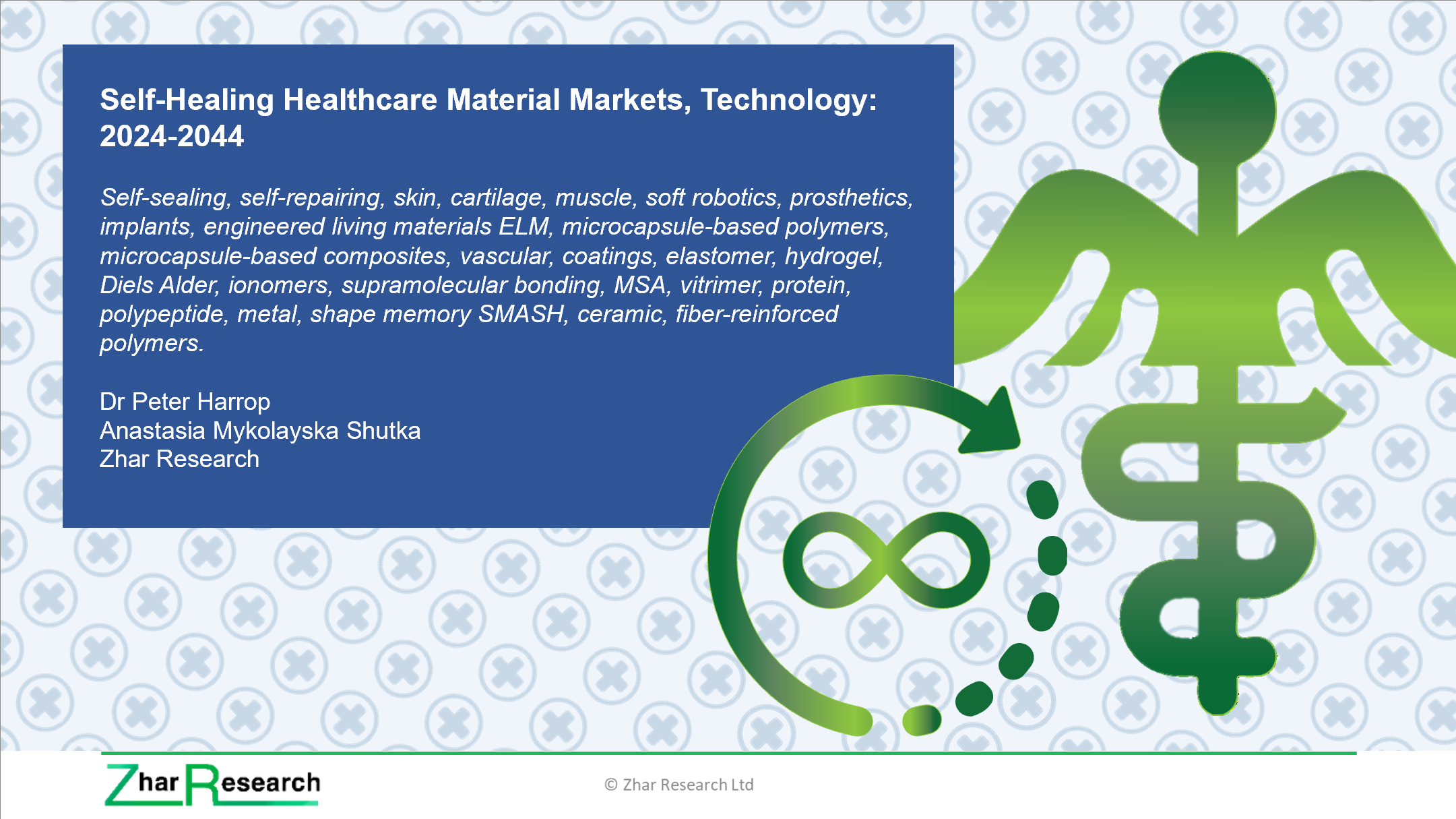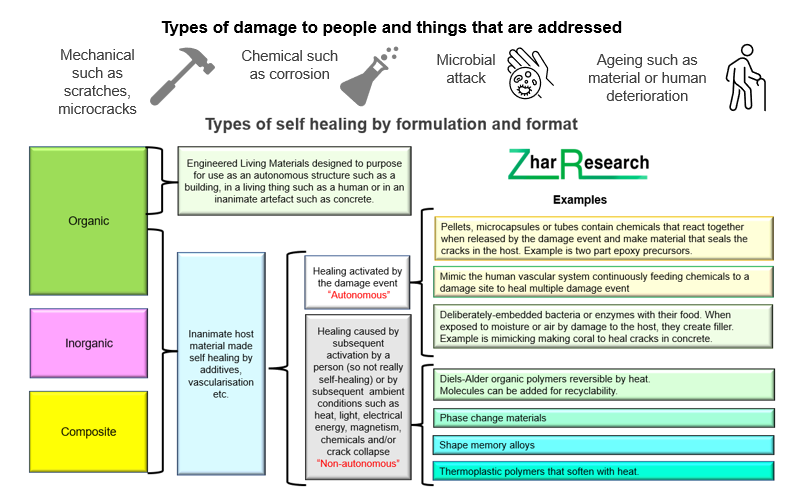Zhar Research Examine the Future of the Self-Healing Healthcare Materials & Tech Market - New Report
The most intense research on self-healing materials concerns healthcare. So much has happened in 2023 that a report on the matter must reflect this.
The most intense research on self-healing materials concerns healthcare. So much has happened in 2023 that a report on the matter must reflect this and be constantly updated so you get the latest. That report is the commercially-oriented new Zhar Research, “Self-Healing Healthcare Material Markets, Technology: 2024-2044” with 360 pages. In the frame are self-healing skin, muscle, cartilage, bone even organ replacement and self-healing microcapsules more reliably delivering medication. Add the quest to make self-healing titanium, batteries and electronics implanted in humans. They will last longer than we do.
Learn the forms of self-healing being applied such as intrinsic and - with other types of microcapsules or with vascular systems - extrinsic. The vast choice of formulations being trialled is carefully analysed as it goes far beyond the vitrimers, hydrogels, ionomers, proteins, and metals forming a part of the study. Indeed, Engineered Living Materials ELM are mostly self-healing and they are becoming significant.
The report is balanced, questioning the need for some proposed solutions such as self-healing textiles when we already have effectively everlasting textiles. Do we need self-healing bone-setting casts being researched? In contrast are prosthetics that grow with a child, parts helping us to live and work to the age of 120 years and providing first class care in the Third World. These are exciting heroic objectives that will lead to many new billion-dollar enterprises. Here are the market forecasts, technology roadmaps and best research leading you to the gaps in the market, best materials, devices, and possible acquisitions to make it a reality. Over 100 companies and over 50 best research papers are cited in six chapters. Match your expertise to the favored atoms, molecules, morphologies, and structures identified here. Clarity is prioritised. There is a glossary but terms are also explained throughout the text. Expect new forecasts, roadmaps, comparisons, infograms, SWOT appraisals and images throughout and no nostalgia or rambling text.
Questions answered include:
Easily grasped new infograms, new comparison tables, new graphs, new roadmaps?
Forecasts for the self-healing materials and for the products likely to use them?
Clarifies maze of different meanings for the term self-healing materials?
Strongly biased towards appraisal of the rapid progress 2023 onwards?
Identifies which research chases non-existent or impossible problems?
Emphasis on your commercial opportunities and gaps in the market?
Appraises the most promising research and best further reading?
Identifies which applications are likely to be large and when?
Identifies applications not addressed that could be large?
Profiles potential partners and most promising startups?
Identifies opportunities for your materials speciality?
PhD level analysis and interviews?
10 new SWOT appraisals?
The 45-page Executive summary and conclusions is sufficient for those in a hurry as it explains the purpose, methodology, definitions, and focus, giving SWOT appraisals of self-healing materials in general and healthcare in particular, needs, primary conclusions, addressable market. See product maturity curves 2024, 2034, 2044, roadmaps of technology and markets 2024-2044 and forecasts both for self-healing materials and for their end uses 2024-2044.
Chapter 2 Introduction takes 13 pages to give context on market drivers and options, explaining the trend to self-healing smart materials, long life, reliability, fit-and-forget, rejuvenation. See how biomimetics – usefully imitating nature - has much further to go and learn the opportunity beyond biomimetics. Recognise the challenges of putting a value on the market, not least because some stretch the logic to include “self-healing” that requires activation after damage. See 18 recent references to recent research, the titles being a taster of what is to come.
Chapter 3 “Self-healing technology toolkit: general” needs 77 pages to analyse inanimate self-healing materials and technologies needed in healthcare. See technology options top down – intrinsic and extrinsic mechanisms, operational, physical, chemical, formulation and format. Sections detail chemical families typically involved, atomic toolkit and the important self-healing materials by application likely to be commercialised from 2024-2044, citing latest research and initiatives.
Understand the dilemma of metrics for self-healing efficacy then specifically examine the toolkit for healing polymers – types, options, difficulty levels. Then we examine the toolkit for intrinsic self-healing of all materials including the importance of nanomaterials, hydrogels, Diels Alder compounds, ionomers, supramolecular bonding, vitrimers, proteins, metals and self-healing under water. Grasp the quest for affordable, sustainable intrinsic self-healing materials. Next comes extrinsic self-healing by microcapsules then by vascular systems then elastomers and shape memory materials. It is all in great detail with SWOT appraisals and latest research throughout.
Zhar Research finds that inanimate self-healing solutions for healthcare will dominate the market over the coming 20 years but, importantly, solutions using growing material will be important in later years. Chapter 4. “Self-healing technology toolkit: Engineered Living Materials ELM” is therefore shorter at 20 pages but they do provide an overview, a SWOT appraisal, these self-healing approaches, bio-ELM vs hybrid ELM and many examples of appropriate ELM research. Bacteria, enzymes and fungi are part of this story.
The subject is then brought alive by the 92 pages of Chapter 5. “Self-healing material applications in healthcare 2024-2044”. An overview is followed by detail on self-healing for artificial human skin, tissue engineering, cell co-culture, organ replacement, artificial muscle and cartilage, bone repair, titanium implants, prosthetics, and soft robotics and for healthcare equipment. After that comes self-healing parts notably membranes, drug delivery microcapsules, implanted electronics, batteries and triboelectric nanogenerators, self-healing biosensors and others. Of course, most of this is only at the stage of research demonstration and trial. The report ends with ten pages of self-healing material company profiles.
Press release distributed by Pressat on behalf of Zhar Research , on Wednesday 31 May, 2023. For more information subscribe and follow https://pressat.co.uk/
Healthcare Medicine Health Materials Self-Healing Regenerating New Materials Technology Forecast Report ELM Business & Finance Consumer Technology Education & Human Resources Health Manufacturing, Engineering & Energy Medical & Pharmaceutical
Published By

anastasiams@zharresearch.com
https://www.zharresearch.com/
Dr Peter Harrop
peterharrop@zharresearch.com
Visit Newsroom
You just read:
Zhar Research Examine the Future of the Self-Healing Healthcare Materials & Tech Market - New Report
News from this source:



